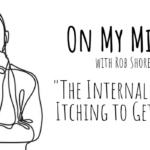That little voice.
It nags all of us from time to time.
It could be the voice uncertainty, anxiety, or fear – but it’s a voice that impedes our full success.
Dr. Jack Singer is both a Professional Speaker and a Professional Sport Psychologist, who, for more than 20 years, has brought the skills he teaches to world class athletes to Financials Sales Professionals.
He teaches sales professionals how to unleash the subconscious barriers to their success.
Developing the Mindset of a Champion Wholesaler
Every elite athlete understands that the difference between consistent championship-level performance and good performance is based on the “Mental Toughness” of the respective athletes. Two athletes with the same skill sets, technique and experience perform differently, based on their mindset, and mental toughness is a main ingredient of that mindset.
It is important to understand that “Mental Toughness” can be easily learned!
Accordingly, good financial services professionals have the “skill set,” knowledge and experience to market their products and services, but the determinant of outstanding performance is the degree of mental toughness they develop to deal with the adversity and challenges that “go with the territory.” I have adapted my athletes’ performance enhancement, mental toughness routine for financial services professionals. It takes only five minutes a day of practicing these seven steps to make a world of difference in your performance.
7 Simple Steps to Quickly Ignite Mental Toughness
(This “Mental Toughness Routine” encompasses scientific research in the fields of “Performance Enhancement,” “Resiliency Training,” and “Burnout Prevention.” Use this 7-step strategy whenever you are stressed, worried, pressured, anxious, and/or have negative thoughts. It takes less than 5 minutes!)
Step #1: Recognize Your Stress Producing, Negative Trigger Thoughts
Negative trigger thoughts are the self-talk patterns that people use to interpret events in their lives. It’s these negative thinking patterns that lead to stress and burnout, not the events themselves.
Example: “I am worried that I will never be able to deal with all of the changes in my industry and I’ll have to look for another career”
Once you understand the trigger thoughts that you have been using, you can stop them in their tracks.
Step #2: Snap the Rubber Band to Stop the Thought Quickly
Get yourself a #64 rubber band (the kind that come with your mail). Keep the rubber band on your wrist and as soon as you recognize a negative trigger thought snap away, while telling yourself to “Stop this silly thinking!”
You might also consider writing a motivating statement on the rubber band and look at it often during the day.
Step #3: Take a Few Deep, Centering Breaths
Relaxation breathing is the first method of calming yourself down from the impact of negative trigger thoughts. Athletes, musicians and singers all understand how to engage this diaphragmatic breathing technique for rapidly calming down.
Take a breath in through your nose and do this for 4 seconds. Then hold it for another 4 seconds, and release out your mouth completely and totally for 7 seconds.
Step #4: Repeat Your Performance Statement to Yourself
A “Performance Statement” is your idea of what it takes to give yourself maximum success in performing your best, consistently.
Example: “Every day, I remind myself that my goal is not perfection. That is unrealistic. Instead, I focus on helping my clients to find the right solutions for their clients. On the way to the office I remind myself to get smarter and wiser this day and be the best wholesaler my clients could work with.”
“I use my new Mental Toughness skills to control my attitude regardless of quotas, because my attitude is critical to the process of selling my products. I am in control of my attitude.”
Step #5: Recall Your Greatest Success- A Personal Highlight Reel
Everyone has had a highlight that they are proud of sometime during their life. It could be a sports highlight, debate team highlight or work-related highlight, for example. It’s important to recall one or more of these, because they identify you in a very positive way.
Close your eyes and visualize that scene, as if it’s a video that you can turn on in your mind any time you wish. Recall where you were, who was watching you, how you felt once you accomplished the feat, etc. The more details the better. This will feel like having a warm blanket of comforting feelings sweeping over you.
Step #6: Repeat Your Identity Statement
In developing your “Identity Statement,” here are the key questions to ask yourself:
- What is a strength I currently have or want to have?
- What do I ultimately want to accomplish?
Now, frame both parts as though the objectives have already been achieved.
Example: “I am the most conscientious and motivated professional in my firm. I am proud of the fact that I can really help my clients to help their clients to feel financially safe. My clients have the utmost trust in me and my recommendations.”
Step #7: Take Another Centering Breath
That’s all there is to it, but this is a really powerful, game-changing technique, if practiced regularly.
Written by Dr. Jack Singer


 The Wisdom of Our Elders is Not Always Right with Nadine Keller
The Wisdom of Our Elders is Not Always Right with Nadine Keller The Rewards of Thinking Big and Being Relentless with Jeffrey Hayzlett
The Rewards of Thinking Big and Being Relentless with Jeffrey Hayzlett Wholesalers, Want to Flourish in the Future? It’s Time to Change Your Mindset with Randy Pennington
Wholesalers, Want to Flourish in the Future? It’s Time to Change Your Mindset with Randy Pennington Wholesalers, Do You Know the Rules of Highly Effective Networking? with Michael Goldberg
Wholesalers, Do You Know the Rules of Highly Effective Networking? with Michael Goldberg On My Mind: The Internal Who’s Itching to Get Out
On My Mind: The Internal Who’s Itching to Get Out